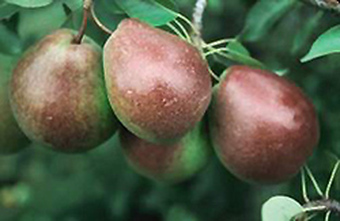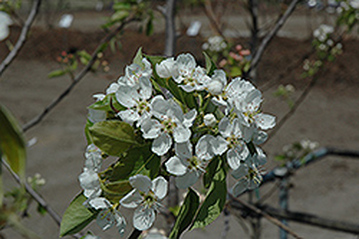Parker Pear
Common Name : Parker pear
Scientific Name : Pyrus parker
Zone : 4 to 8
Height : 15 to 20 feet
Width : 15 feet
Culture :
This tree should only be grown in full sunlight. It does best in average to evenly moist conditions, but will not tolerate standing water. It is not particular as to soil type or pH, and is subject to chlorosis (yellowing) of the leaves in alkaline soils. It is highly tolerant of urban pollution and will even thrive in inner city environments. This is a high maintenance tree that will require regular care and upkeep, and is best pruned in late winter once the threat of extreme cold has passed. Gardeners should be aware of the following characteristic(s) that may warrant special consideration.
Description :
A compact and hardy pear, this University of Minnesota introduction produces tasty medium-sized reddish-brown fruit in late summer on an upright and vigorous plant, showy white flowers in spring; a great choice for the home orchard. Parker Pear is blanketed in stunning clusters of white flowers with purple anthers along the branches in mid spring. It has dark green foliage throughout the season. The glossy pointy leaves turn an outstanding deep purple in the fall. The fruits are showy indian red pomes carried in abundance in late summer, which are excellent for fresh eating and making jams and jellies but which can be messy if allowed to drop on the lawn or walkways. This variety requires a different selection of the same species growing nearby in order to set fruit. The furrowed brown bark is not particularly outstanding. Parker Pear is a dense deciduous tree with an upright spreading habit of growth. Its average texture blends into the landscape, but can be balanced by one or two finer or coarser trees or shrubs for an effective composition.
Problem :
Very susceptible to fireblight, particularly in years with warm and wet spring weather. Additional disease problems include anthracnose, canker, scab and powdery mildew. Insect visitors include pear psylla, coddling moth and borers.
Garden Uses:
Althought the early spring flowers are beautiful and the fruit is attractive, Parker pear is normally grown only for its fruit crop and not as an ornamental. May be espaliered.
http://plants.bachmanslandscaping.com/12070012/Plant/3932
Common Name : Parker pear
Scientific Name : Pyrus parker
Zone : 4 to 8
Height : 15 to 20 feet
Width : 15 feet
Culture :
This tree should only be grown in full sunlight. It does best in average to evenly moist conditions, but will not tolerate standing water. It is not particular as to soil type or pH, and is subject to chlorosis (yellowing) of the leaves in alkaline soils. It is highly tolerant of urban pollution and will even thrive in inner city environments. This is a high maintenance tree that will require regular care and upkeep, and is best pruned in late winter once the threat of extreme cold has passed. Gardeners should be aware of the following characteristic(s) that may warrant special consideration.
Description :
A compact and hardy pear, this University of Minnesota introduction produces tasty medium-sized reddish-brown fruit in late summer on an upright and vigorous plant, showy white flowers in spring; a great choice for the home orchard. Parker Pear is blanketed in stunning clusters of white flowers with purple anthers along the branches in mid spring. It has dark green foliage throughout the season. The glossy pointy leaves turn an outstanding deep purple in the fall. The fruits are showy indian red pomes carried in abundance in late summer, which are excellent for fresh eating and making jams and jellies but which can be messy if allowed to drop on the lawn or walkways. This variety requires a different selection of the same species growing nearby in order to set fruit. The furrowed brown bark is not particularly outstanding. Parker Pear is a dense deciduous tree with an upright spreading habit of growth. Its average texture blends into the landscape, but can be balanced by one or two finer or coarser trees or shrubs for an effective composition.
Problem :
Very susceptible to fireblight, particularly in years with warm and wet spring weather. Additional disease problems include anthracnose, canker, scab and powdery mildew. Insect visitors include pear psylla, coddling moth and borers.
Garden Uses:
Althought the early spring flowers are beautiful and the fruit is attractive, Parker pear is normally grown only for its fruit crop and not as an ornamental. May be espaliered.
http://plants.bachmanslandscaping.com/12070012/Plant/3932


